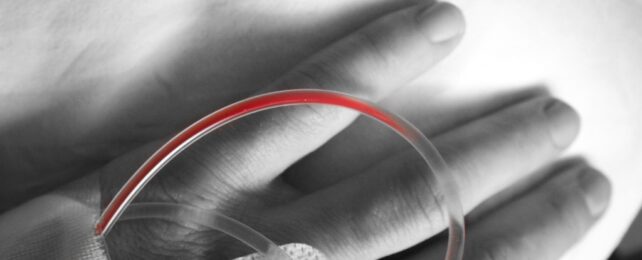When actor Orlando Bloom revealed recently that he'd undergone a procedure to have his blood "cleaned", many people raised eyebrows.
The Pirates of the Caribbean star had turned to a treatment known as apheresis – a medical process in which blood is removed from the body, centrifuged or filtered to extract certain components, then returned in an attempt to flush out microplastics and other toxins.
Apheresis is typically used to treat conditions such as autoimmune diseases or abnormally high levels of blood cells or proteins. Its use as a detox for microplastics, however, is scientifically unproven.
Still, Bloom said he suspected his body had absorbed plastic through daily exposure, and wanted it out of his system.
Related: It's Official, Microplastics Were Found Circulating in Human Blood For The First Time
He's probably right about the exposure. Scientists have found microplastics – tiny plastic fragments less than 5 mm in size – in our air, water, soil, food and even inside human tissue. But when it comes to removing them from the bloodstream, that's where the science gets murky.

As researchers studying microplastic contamination, we've examined this issue in the context of dialysis – a life-saving treatment for patients with kidney failure. Dialysis filters waste products like urea and creatinine from the blood, regulates electrolytes, removes excess fluid and helps maintain blood pressure.
But our study found that while dialysis is a medical marvel, it can also have an ironic downside: it could be introducing microplastics into the bloodstream. In some cases, we found that patients undergoing dialysis were being exposed to microplastics during treatment due to the breakdown of plastic components in the equipment – a troubling contradiction for a procedure designed to cleanse the blood.
Apheresis is closely related to dialysis: both involve drawing blood from the body, circulating it through plastic tubing and filters, then returning it – so both procedures carry a similar risk of introducing microplastics from the equipment into the bloodstream.
What are microplastics?
Microplastics are plastic particles that range in size from about 5mm (roughly the length of a grain of rice) down to 0.1 microns – smaller than a red blood cell.
Some microplastics are manufactured deliberately, like the plastic microbeads once common in facial scrubs. Others form when larger plastic objects degrade over time due to sunlight, friction, or physical stress.
They're everywhere: in the food we eat, air we breathe and water we drink. Plastic packaging, synthetic clothing such as polyester, and even artificial lawns contribute to the spread. Car tyres shed plastic particles as they wear down, and food heated or stored in plastic containers may leach microplastics.
One estimate suggests the average adult may ingest around 883 microplastic particles – over half a microgramme – per day.
So far, large-scale epidemiological studies have not established an association between microplastic exposure and specific diseases. Such studies are needed, but yet to be completed.
However, early research suggests that microplastics may be associated with inflammation, cardiovascular conditions, and DNA damage – a potential pathway to cancer.
What remains unclear is how microplastics behave inside the body: whether they accumulate, how they interact with tissues, and how (or if) the body clears them.
The irony of filtration
It's tempting to believe, as Bloom seems to, that we can simply "clean" the blood, like draining pasta or purifying drinking water. Just as a sieve filters water from pasta, dialysis machines do filter blood – but using far more complex and delicate systems.
These machines rely on plastic components, including tubes, membranes and filters, which are exposed to sustained pressure and repeated use. Unlike stainless steel, these materials can degrade over time, potentially shedding microplastics directly into the bloodstream.

Currently, there is no published scientific evidence that microplastics can be effectively filtered from human blood. So, claims that dialysis or other treatments can remove them should be viewed with scepticism, especially when the filtration systems themselves are made of plastic.
While it's tempting to chase quick fixes or celebrity-endorsed cleanses, we are still in the early stages of understanding what microplastics are doing to our bodies – and how to get rid of them. Rather than focusing solely on ways to flush plastics from the bloodstream, the more effective long-term strategy may be reducing our exposure in the first place.
Bloom's story taps into a growing public unease: we all know we're carrying the burden of plastic. But addressing it requires more than wellness trends: it calls for rigorous science, tougher regulation, and a shift away from our reliance on plastic in daily life.
This article is republished from The Conversation under a Creative Commons license. Read the original article.
